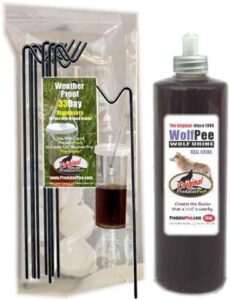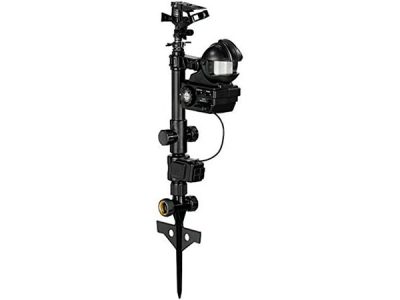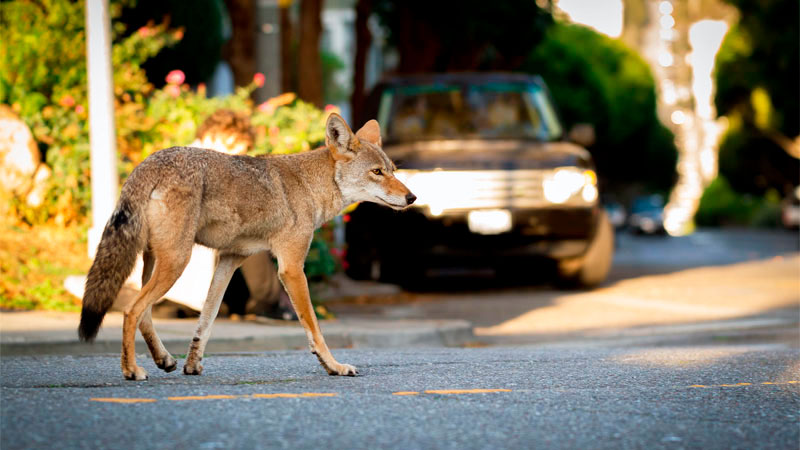Coyotes are increasingly encroaching on residential areas, creating safety concerns for homeowners and their pets. The most effective approach to coyote control involves making your property undesirable through strategic repellents, barriers, and behavioral modification techniques. This comprehensive guide covers proven methods including scent deterrents, physical barriers, hazing techniques, and preventative measures to keep coyotes away from your property safely and humanely.
Quick Picks: Best Coyote Repellent Products

Editor’s Choice

Best Value
Understanding Coyotes: Essential Knowledge Before Repelling

Before implementing any coyote repellent strategy, it’s crucial to understand what you’re dealing with. Proper identification, behavior patterns, and legal considerations form the foundation of effective coyote management.
Coyote Identification and Distinguishing Features
Coyotes (Canis latrans) are often mistaken for domestic dogs or wolves, making accurate identification essential for appropriate response measures.
Physical Characteristics
- Sleek build with narrow, pointed snout
- Flatter forehead compared to domestic dogs
- Elongated legs and lean body structure
- Dark-tipped tail that hangs low while running
- Weight typically ranges from 20-50 pounds
Tracks and Sign
- Narrow tracks compared to domestic dogs
- Straight travel paths (unlike wandering dog paths)
- Scat contains hair, bones, and fur remnants
- Droppings are rope-like, 1 inch thick, 4-7 inches long
- Strong, persistent odor from territorial marking
Coyote Behavior and Activity Patterns
Understanding when and why coyotes are active helps determine the best timing and placement for repellent strategies.
- Primary Activity: Most active during dawn and dusk (crepuscular), but can be seen during daylight hours, especially during mating season (January-March) and while raising young.
- Habitat Preferences: Originally prairie and desert dwellers, coyotes have adapted to virtually every habitat including urban and suburban areas.
- Territorial Behavior: Use vocalizations like howling to communicate with pack members and establish territory boundaries.
- Food Sources: Opportunistic feeders consuming small mammals, birds, fruits, vegetables, pet food, and garbage.
Legal Considerations and Safety
While coyote attacks on humans remain rare, understanding the risks helps ensure safe implementation of repellent strategies:
- Risk Assessment: Greatest risk to unvaccinated pets and small children
- Daytime Sightings: Seeing a coyote during daylight doesn’t indicate rabies or aggression
- Professional Help: Contact licensed wildlife control if lethal methods become necessary
Proven Coyote Repellent Methods
Effective coyote control requires a multi-faceted approach combining several deterrent methods. The following strategies have proven most successful when used consistently and in combination.
Hazing Techniques: Teaching Coyotes to Fear Humans
Hazing is the most effective long-term strategy for coyote control, teaching them to associate human presence with unpleasant experiences.
Essential Hazing Techniques
- Noise: Yelling, air horns, whistles, pot banging, or penny-filled cans
- Motion: Wave arms overhead while making noise to appear larger
- Water: Garden hose, water gun, or motion-activated sprinklers
- Projectiles: Throw sticks or tennis balls near (not at) the coyote
- Scents: Spray vinegar, pepper spray, or predator urine
Scent-Based Repellents
Odor repellents work by creating an unpleasant or threatening scent environment that encourages coyotes to avoid the area.
Predator Urine – Most Effective Natural Deterrent
Wolf and bear urine trigger coyotes’ natural fear response, making this one of the most effective repellent methods.
PredatorPee 100% Pure Wolf Urine Kit
Editor's ChoiceHow Does It Work
How to Use
- Install stakes around your property perimeter at 10-15 foot intervals
- Fill dispensers with wolf urine and attach to stakes
- Position dispensers 2-3 feet off the ground for optimal scent dispersal
- Refresh urine every 30-33 days or after heavy rainfall
- Focus placement around areas where coyotes have been spotted
- Triggers natural predator-prey response in coyotes
- Weatherproof dispensers protect against rain
- Long-lasting formula reduces reapplication frequency
- Easy-to-use stake system for quick installation
- Covers large perimeter areas effectively
- Requires regular reapplication every 30+ days
- Strong odor may be noticeable to humans
- More expensive than homemade alternatives
| Repellent Type | Effectiveness | Duration | Application Method | Cost |
|---|---|---|---|---|
| Wolf Urine | Very High | 30-35 days | Dispensers/Spraying | $$$ |
| Bear Urine | High | 25-30 days | Cotton balls/Spraying | $$ |
| Ammonia | Medium | 7-10 days | Soaked rags | $ |
| White Vinegar | Medium | 3-5 days | Spraying/Cotton balls | $ |
| Pepper Spray | Medium-High | 5-7 days | Homemade spray | $ |
DIY Scent Repellent Recipes
- 24 hot chili peppers (red or green)
- ½ gallon water
- ¼ cup white vinegar
- Slow cook in crockpot for 8 hours or place in direct sunlight
- Strain and spray around perimeter twice weekly
Application Tips for Scent Repellents:
- Apply around property perimeter, focusing on entry points
- Treat tree trunks and bases up to 3 feet high
- Reapply after rain or according to product instructions
- Use multiple scent types in rotation to prevent habituation
Physical Barriers and Fencing
While more expensive initially, proper fencing provides the most reliable long-term coyote exclusion.
Fence Specifications
- Minimum 6 feet tall
- Buried apron 12-18 inches deep
- Angled top extending 15+ inches outward
- No gaps larger than 4 inches
- Smooth surface to prevent climbing
Enhancement Options
- Roller bars on top to prevent climbing
- Electric wire deterrent (where legal)
- Coyote rollers for existing fences
- Motion-activated lighting along fence line
Motion-Activated Deterrent Devices
Electronic deterrents work best when positioned at coyote eye level and covering multiple approach angles.
Motion-Activated Sprinkler System
Best ValueHow Does It Work
How to Use
- Install 20-30 inches from ground at coyote eye level
- Position to cover main approach routes and den areas
- Adjust sensitivity to avoid triggering on small animals
- Set spray pattern to cover 10-15 foot radius
- Use multiple units for comprehensive coverage
- Solar powered - no electrical connections needed
- Adjustable sensitivity and spray patterns
- Works 24/7 without human intervention
- Also deters other unwanted wildlife
- Environmentally friendly water-based deterrent
- Requires periodic cleaning and maintenance
- May trigger on non-target animals
- Less effective in freezing temperatures
Property Management and Prevention
The most effective coyote control involves eliminating attractions that draw them to your property in the first place.

Remove Food Sources
- Secure Garbage: Use tight-fitting lids and consider wildlife-proof containers. Store bins in enclosed areas until pickup day.
- Pet Food Management: Feed pets indoors or remove dishes immediately after feeding. Never leave food outside overnight.
- Bird Feeder Maintenance: Clean up spilled seed regularly and consider temporary removal if coyote activity increases.
- Fruit Tree Care: Harvest fruit promptly and clean up fallen fruit daily. Consider protective netting during fruiting season.
Eliminate Shelter and Den Sites
Coyotes seek protected areas for denning and resting. Removing these opportunities forces them to look elsewhere.
Habitat Modification Checklist
- Seal openings under decks, porches, and sheds
- Trim overgrown landscaping and brush piles
- Remove or secure compost piles
- Install barriers around potential den sites
- Keep grass mowed and remove debris piles
Pet and Livestock Protection
Essential Protection Measures:
- Leash Protocol: Keep dogs on 6-foot leashes during walks in coyote-active areas
- Indoor Cats: Keep cats indoors, especially during nighttime hours
- Secure Enclosures: Use fully enclosed runs with overhead protection for outdoor pet time
- Vaccination Updates: Ensure all pets have current rabies and other vaccinations
- Guardian Animals: Consider livestock guardian dogs, llamas, or donkeys for larger properties
Advanced Coyote Control Strategies
Integrated Pest Management Approach
The most successful coyote control programs combine multiple deterrent methods while addressing the underlying factors that attract coyotes.
| Season | Coyote Activity | Primary Methods | Maintenance Focus |
|---|---|---|---|
| Winter (Dec-Feb) | Mating season – High activity | Intensive hazing, fresh scent repellents | Daily scent refreshing, increased vigilance |
| Spring (Mar-May) | Denning and pup-rearing | Perimeter barriers, motion devices | Seal den sites, enhance physical barriers |
| Summer (Jun-Aug) | Teaching young to hunt | Food source elimination, protection protocols | Fruit cleanup, pet supervision |
| Fall (Sep-Nov) | Dispersal of young | Maintain existing deterrents | Prepare winter repellent supplies |
When to Call Professionals
Certain situations require professional wildlife control intervention:
- Aggressive coyote behavior toward humans
- Persistent den sites on property despite deterrent efforts
- Repeated livestock or pet attacks
- Coyotes showing signs of illness or unusual behavior
- Local regulations requiring licensed removal
Frequently Asked Questions
How long does it take for coyote repellents to work?
Most coyote repellent methods show initial results within 1-2 weeks of consistent application. However, because coyotes are territorial animals, it typically takes 2-4 weeks of persistent deterrent efforts before they establish new territories elsewhere.
Scent-based repellents may show immediate avoidance behaviors, while hazing techniques require several encounters to establish lasting fear responses.
Are coyote repellents safe for pets and children?
Most commercial coyote repellents are formulated to be safe around pets and children when used according to label directions. However, predator urine products should be placed out of reach, and homemade pepper sprays can cause irritation if contacted directly.
Always read product labels carefully and consider physical barriers like dispensers or elevated placement to prevent accidental contact.
Do ultrasonic devices work for coyote control?
Research shows mixed results for ultrasonic devices in coyote control. While some studies indicate temporary deterrent effects, coyotes often habituate to consistent sounds. Traditional methods like scent repellents and hazing techniques generally prove more reliable.
If using ultrasonic devices, combine them with other deterrent methods and rotate their placement regularly to prevent habituation.
What should I do if I encounter a coyote during the day?
Daytime coyote sightings don’t necessarily indicate rabies or aggression. Maintain eye contact, make yourself appear larger by raising your arms, and use hazing techniques like loud noises. Never turn your back or run from a coyote.
If the coyote doesn’t retreat after hazing attempts, slowly back away while continuing to face the animal and make noise. Contact local wildlife authorities if the coyote shows signs of illness or unusual aggression.
How often should I reapply scent-based repellents?
Reapplication frequency depends on the specific repellent and weather conditions. Commercial predator urine products typically last 30-35 days, while homemade solutions like vinegar or pepper spray need refreshing every 3-7 days.
Heavy rainfall, snow, or extreme temperatures can reduce effectiveness, requiring more frequent application. Monitor your property for signs of renewed coyote activity as an indicator for reapplication.
Can I use multiple repellent methods simultaneously?
Yes, combining multiple deterrent methods is actually the most effective approach. Use scent repellents around the perimeter, install motion-activated devices at key points, and practice hazing when encounters occur.
Rotate different scent types and hazing techniques to prevent coyotes from becoming habituated to any single deterrent method.
Conclusion
Effective coyote control requires a comprehensive approach combining immediate deterrents with long-term habitat modification. The most successful strategies use multiple repellent methods simultaneously while addressing the underlying factors that attract coyotes to residential areas.
Start with proven techniques like predator urine applications and hazing protocols, then enhance your program with physical barriers and motion-activated devices based on your specific situation. Remember that consistency and persistence are key – coyotes are intelligent, adaptable animals that require sustained deterrent pressure to establish new territorial boundaries.
For persistent problems or safety concerns, don’t hesitate to contact licensed wildlife control professionals who can provide specialized solutions and ensure compliance with local regulations. With the right combination of deterrent methods and property management practices, you can successfully keep coyotes away from your home and family.

